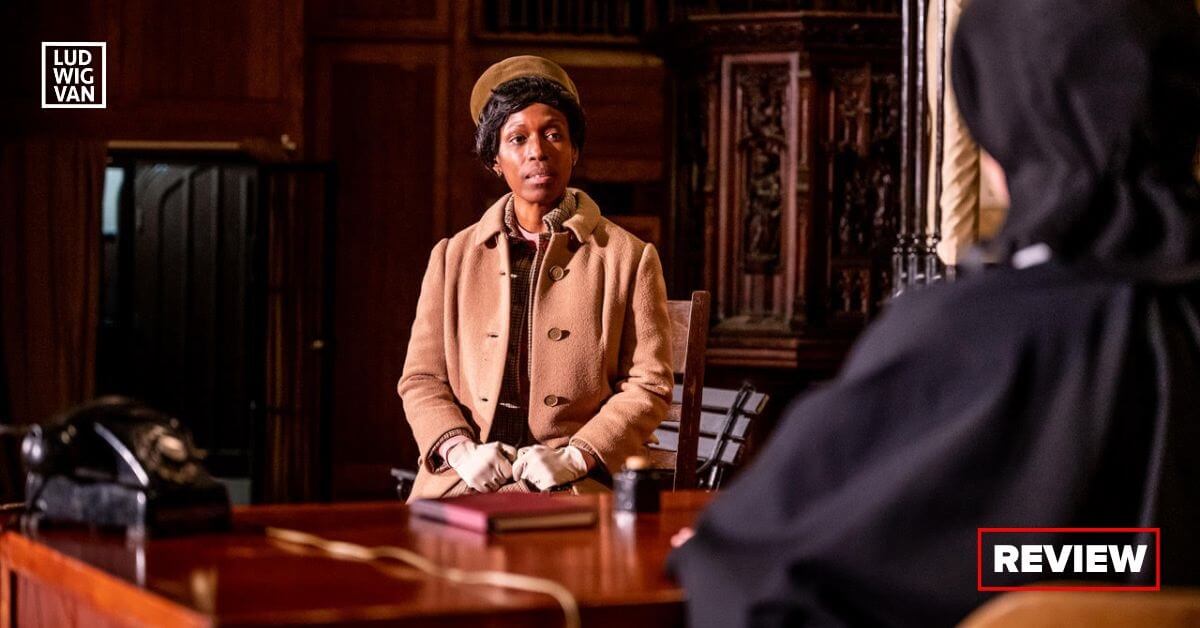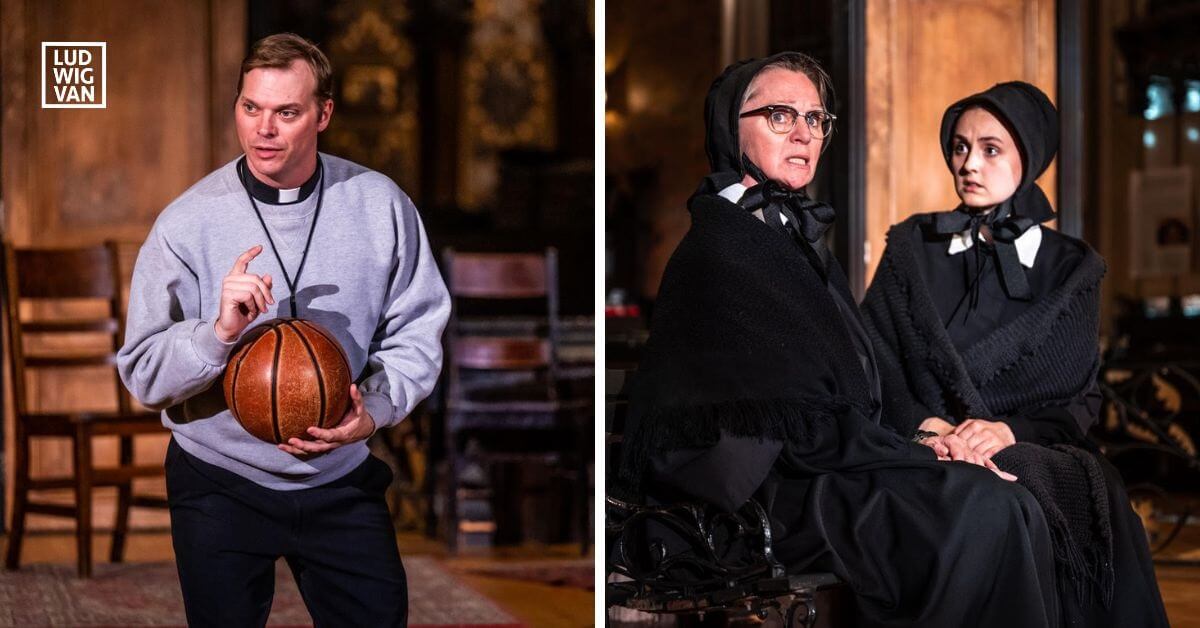
B&E Theatre/Doubt: A Parable, written by John Patrick Shanley, directed by Stewart Arnott, Church of the Holy Trinity, Oct. 27 to Nov. 13. Tickets available here.
B&E Theatre is a brand new company making its Toronto stage debut. To say that this little enterprise has cojones is an understatement. Its inaugural offering is none other than John Patrick Shanley’s Pulitzer/Tony-winning 2004 play Doubt: A Parable.
I suspect that most people have seen the play in some form, whether in the theatre or via the 2008 Oscar-nominated film. For example, this is my fourth go round (two theatres/one film). Therefore, from my point of view, B&E’s task was to say something new, or why mount this modern classic? More to the point, why should audiences come?
How did B&E do? The answer is, the production is pretty impressive for a first go-round.
On a personal level, I heard the text more deeply. I was caught up by the performances. I was engulfed by the setting, and I more deeply understood why Shanley set the play back in time — and why he tacked on “A Parable” to the title when the play was published.
The story line is simple, but ruthlessly current. Shanley’s play takes place in 1964, but it certainly has resonance for today, given all the wrongdoing within the Catholic Church and child abuse.
Sister Aloysius (Deborah Drakeford) is the arch-conservative, martinet principal of St. Nicholas Church School in the Bronx. She is suspicious of the relationship between the easygoing Father Flynn (Brian Bisson) and a young Grade 8 student, and enlists the aid of the boy’s young and impressionable teacher, Sister James (Emma Nelles), to help her find proof of misconduct.
It doesn’t help matters that the boy is the first Black student at St. Nicholas, which makes the matter all the more sensitive. The fourth character is the boy’s mother, Mrs. Muller (Kim Nelson), whom Sister Aloysius calls in to a meeting about the situation as she sees it.
At the heart of this production is the setting. The performances take place at the historic Anglican Church of the Holy Trinity, one of the city’s oldest, which first opened its doors in 1847. There isn’t a set designer listed, so one assumes “Props” by David Hoekstra and John Rubino covers the issue.
The stage is the raised platform before the choir, and a door to Sister Aloysius’s office has been placed in the gated opening, with a desk and chairs added. On the other side is a bench. Father Flynn uses the raised pulpit and the floor in front of the audience.
Always within the audience’s view are the magnificent stained-glass windows behind the altar, and the overpowering image of the huge organ pipes which dominate the ceiling and walls. As you watch the play, you feel dwarfed by the majesty of Holy Trinity, which augments the power of Sister Aloysius’s crusade.
What a clever, clever setting, so a big plus for B&E’s first adventure on this front.
If you are going to put on a well-known vehicle, you should nab a director who can bring something more to the table than the obvious. In this case, Doubt: A Parable has been helmed by Stewart Arnott, fresh off his Dora win for Coalmine’s Marjorie Prime, starring the late Martha Henry.
At first, I found the action a trifle slow, until I realized that Arnott wanted us to listen very closely to every word of the text. Shanley has packed in a lot of dialogue that could be glossed over if spoken quickly.

A good example is Father Flynn’s closing speech. Tucked in the middle are incredibly important sentences about his previous parish that I heard more fully than in my other three times. Instead of a glancing blow, I got a fuller picture. Obviously, I don’t want to give anything away, but it was a revelation.
The slow and deliberate unfolding of the script allows character arcs to develop more deeply. The obvious one is Sister James, and Nelles is outstanding as we watch an enthusiastic young teacher see her love for her chosen profession be destroyed by the authoritative, autocratic miasma of Sister Aloysius’ poison.
Arnott’s careful handling of the words also makes the encounters between people all the more intense. The dialogue that is said really matters when we witness Sister Aloysius with both Father Flynn and Mrs. Muller. Each case is a chess match, with the Sister driving full tilt towards her checkmate.
Watching Bisson’s Flynn go from a self-possessed, amiable young man to a floundering weakling whose rug has been pulled from under him is not easy. Arnott has given Flynn a little bit of strength at the end, which is subtle, but important, and something we wouldn’t catch in a faster paced production. Bisson performs that arc very well. It is the most difficult in the play, as he has to find a way to go realistically from confident to collapse.
Kim Nelson’s Mrs. Muller proves to be a worthy opponent to Sister Aloysius, even though she is being slowly broken in the face of the nun’s relentless pursuit of her goal. Their meeting is much more vicious than I’ve seen before, and therefore, much more heartrending. Arnott has given Mrs. Muller strength in her weakness, and Nelson is nothing short of magnificent.
Which brings us to Drakeford’s Sister Aloysius. The character can be played on one note — a woman so convinced of her righteous cause that she tramples all before her — yet, for the first time, I had some sympathy for her, and the possibility that she could be motivated by good intentions. On the other hand, Arnott has layered into her character a subtle anger at Father Flynn’s popularity, and jealousy of his natural charm.
In short, director Arnott has given the nun a richer character, and it’s the slower pacing that allowed me to catch it. Sister Aloysius is more complex than you would think, and when she finally does begin to lose her grip — shouting out her frustration — I literally jumped in my seat at her hysterical outburst. For Drakeford, this is a role of a lifetime.
The costumes (Lara Berry), lighting (Gareth Crew) and sound design (Arnott, Jack Considine and J.D. Smith) are unobtrusive yet suitable, allowing Arnott’s vision of a deeper and more profound look into this play to take hold.
Several days after attending the production, I still have scenes from the play buzzing around my head, proving that as a director, Arnott and his actors have found both the mine shaft and the mine. More to the point, I came away with a lot more doubt, in every quarter, than I had felt before.
Doubt: A Parable is a gutsy beginning for B&E Theatre, and I await their next venture.
#LUDWIGVAN
Get the daily arts news straight to your inbox.
Sign up for the Ludwig van Daily — classical music and opera in five minutes or less HERE.
- INTERVIEW | Actor Diego Matamoros Takes On Icon Walt Disney In Soulpepper Production Of Hnath Play - April 16, 2024
- SCRUTINY | Opera In Concert Shine A Light On Verdi’s Seldom Heard La Battaglia Di Legnano - April 9, 2024
- SCRUTINY | Lepage & Côté’s Hamlet Dazzles With Dance And Stagecraft Without Saying Anything New - April 5, 2024



